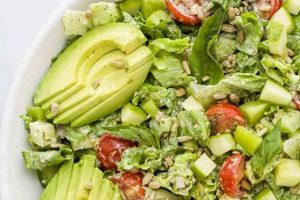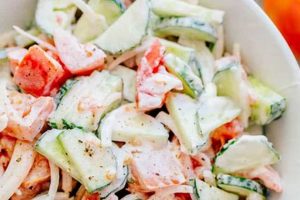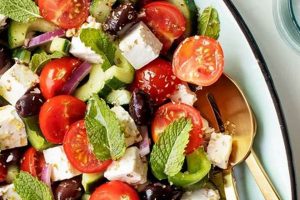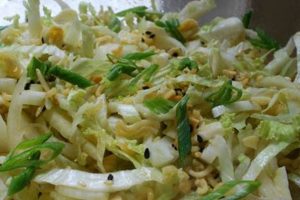This classic dish typically features boiled potatoes combined with mayonnaise, mustard, celery, onion, and sometimes hard-boiled eggs, pickles, or relish. Variations can include different types of mustard, the addition of sweet pickle relish, or even a touch of sugar for a sweeter profile. A defining characteristic is often the use of yellow mustard, contributing to its signature tangy flavor.
A staple at picnics, potlucks, and family gatherings across the American South, this side dish represents more than just a culinary creation. Its presence on tables signifies tradition, comfort, and shared experiences. The specific ingredients and preparation methods often vary from family to family, creating unique versions passed down through generations. This personal touch imbues the dish with a sense of heritage and nostalgia.
From exploring regional variations to examining the evolution of this beloved side dish, the following sections will delve deeper into the world of this quintessential comfort food, offering insights into its preparation, history, and cultural significance.
Tips for Perfect Potato Salad
Achieving optimal results requires attention to detail throughout the preparation process. These tips offer guidance for creating a delicious and memorable dish.
Tip 1: Potato Selection and Cooking: Opt for waxy potatoes like Yukon Gold or red-skinned varieties, as they hold their shape well after boiling. Avoid overcooking; potatoes should be tender but not mushy.
Tip 2: Dressing Consistency: The balance of mayonnaise and mustard contributes significantly to the overall flavor profile. Adjust the ratio to suit individual preferences, ensuring the dressing is creamy and well-combined.
Tip 3: Ingredient Incorporation: Add the dressing while the potatoes are still slightly warm. This allows for better absorption and flavor distribution.
Tip 4: Seasoning and Flavor Enhancement: Salt and pepper are essential, but consider incorporating additional seasonings such as celery seed, paprika, or a dash of hot sauce for added complexity.
Tip 5: Chilling and Serving: Allow the salad to chill thoroughly in the refrigerator for at least two hours before serving. This allows the flavors to meld and enhances the overall texture.
Tip 6: Garnishing and Presentation: A sprinkle of paprika, chopped fresh parsley, or a few slices of hard-boiled egg can elevate the presentation and add a final touch of flavor.
Tip 7: Ingredient Freshness: Using fresh, high-quality ingredients significantly impacts the final product. Opt for crisp celery, pungent onions, and flavorful mustard.
By following these guidelines, one can create a potato salad that balances flavor, texture, and visual appeal, ensuring a satisfying culinary experience.
From ingredient selection to chilling and serving, the nuances of preparation contribute to the overall success of this classic dish. The following section will offer concluding thoughts and further insights.
1. Waxy Potatoes (Yukon Gold)
Waxy potatoes, particularly Yukon Golds, play a crucial role in Southern potato salad. Their lower starch content allows them to maintain their shape after boiling, preventing them from becoming mushy or disintegrating when mixed with the other ingredients. This characteristic is essential for the desired texture of the salad, which should be creamy but not gluey. Russet potatoes, with their higher starch content, tend to break down during cooking, resulting in a less desirable consistency. Choosing waxy potatoes ensures the salad retains its structural integrity, offering a pleasant bite.
The firm texture of waxy potatoes also contributes to the salad’s ability to hold its shape when served. This is especially important for gatherings where the salad might sit out for a period. The potatoes remain distinct and visually appealing, rather than collapsing into a homogenous mass. Beyond texture, Yukon Golds offer a subtly sweet and buttery flavor that complements the other ingredients in the salad, enhancing the overall taste experience. This inherent sweetness balances the tanginess of the mustard and the richness of the mayonnaise, creating a harmonious flavor profile.
The selection of the correct potato variety directly impacts the final quality of Southern potato salad. Waxy potatoes like Yukon Golds offer the ideal combination of texture and flavor, ensuring a successful and enjoyable dish. Their ability to retain their shape and their subtle sweetness make them a superior choice for this classic Southern staple. Utilizing other varieties can compromise the structural integrity and flavor balance, potentially resulting in a less satisfying culinary outcome.
2. Mustard (yellow preferred)
Mustard plays a pivotal role in defining the characteristic flavor profile of Southern potato salad. While Dijon or stone-ground mustard might find their place in other variations, yellow mustard stands as the traditional choice, contributing a tangy, slightly spicy, and subtly sweet note that balances the richness of the mayonnaise and the sweetness of other ingredients like relish or potatoes themselves. This specific type of mustard, often readily available and affordable, has become deeply ingrained in the culinary traditions of the region, passed down through generations of family recipes. Its bright yellow color also contributes to the visual appeal of the finished dish.
The choice of yellow mustard over other varieties creates a distinct flavor profile that sets Southern potato salad apart. For instance, the robust, complex flavors of Dijon mustard, while suitable for some dishes, can overpower the delicate balance of flavors in a traditional Southern potato salad. Similarly, the coarse texture of stone-ground mustard might clash with the creamy consistency typically desired. Yellow mustard’s smooth texture and balanced flavor seamlessly integrate with the other components, creating a harmonious blend. This preference for yellow mustard often stems from historical availability and affordability, reinforcing its status as a pantry staple in Southern kitchens. This historical context solidifies its place in traditional recipes and underscores its cultural significance.
Understanding the specific role of yellow mustard in Southern potato salad provides valuable insight into the dish’s cultural and culinary identity. It highlights the importance of ingredient selection in achieving the desired flavor profile and emphasizes the connection between tradition, affordability, and taste. While variations exist, adhering to the traditional use of yellow mustard ensures a taste that resonates with the historical and cultural roots of this iconic Southern side dish. This appreciation for the nuances of specific ingredients contributes to a deeper understanding of regional culinary traditions and the evolution of classic recipes.
3. Mayonnaise (Duke's Often Favored)
Mayonnaise serves as a foundational element in Southern potato salad, binding the ingredients and contributing a creamy texture crucial to the dish’s overall appeal. Within the context of Southern cuisine, Duke’s mayonnaise often holds a position of distinction, frequently cited as the preferred choice for its specific flavor profile and textural qualities.
- Tangy Flavor Profile:
Duke’s mayonnaise possesses a characteristic tanginess derived from its higher proportion of vinegar compared to other brands. This tang provides a counterpoint to the richness of the mayonnaise itself and complements the other ingredients in the salad, such as potatoes, mustard, and celery. This distinct tang sets it apart, contributing to the unique flavor profile often associated with authentic Southern potato salad. Other mayonnaise brands, with their milder flavor profiles, might not provide the same level of complexity or balance.
- Textural Influence:
Duke’s mayonnaise exhibits a specific texture described as “fluffier” or less dense than some competitors. This characteristic affects the overall consistency of the potato salad, contributing to a lighter, less heavy mouthfeel. A denser mayonnaise might result in a salad perceived as overly rich or thick. This textural nuance plays a crucial role in the final sensory experience of the dish.
- Regional Preference and Cultural Significance:
Duke’s mayonnaise enjoys a strong regional following, particularly in the Southern United States. This preference reflects not only its flavor profile but also its cultural significance. Often associated with family gatherings and traditional recipes, Duke’s mayonnaise represents a connection to culinary heritage and regional identity. Choosing Duke’s can be a way of preserving culinary traditions and expressing a connection to Southern culinary heritage.
- Recipe Adaptability:
While Duke’s mayonnaise is often cited as the preferred choice, recipes can adapt to accommodate other brands. Adjustments might be necessary to achieve the desired flavor balance. For example, increasing the amount of vinegar or adding a touch of lemon juice can help replicate the tanginess characteristic of Duke’s. Understanding the specific qualities of Duke’s allows for informed substitutions, ensuring the final product aligns with the intended flavor profile.
The choice of mayonnaise, particularly the frequent preference for Duke’s, significantly influences the flavor, texture, and cultural significance of Southern potato salad. This seemingly simple ingredient plays a complex role in shaping the dish’s identity and contributes to the overall dining experience. From its tangy flavor to its regional significance, the selection of mayonnaise represents a crucial decision in crafting an authentic and satisfying Southern potato salad.
4. Celery (diced finely)
Finely diced celery constitutes a crucial textural and flavor component within southern potato salad. Its crispness offers a refreshing counterpoint to the creamy mayonnaise and soft potatoes. This contrast prevents the salad from becoming overly rich or monotonous in texture, contributing to a more dynamic and enjoyable sensory experience. Beyond texture, celery imparts a subtle, slightly herbaceous flavor that complements the other ingredients without overpowering the overall profile. This delicate flavor enhancement adds depth and complexity to the salad, preventing it from tasting bland or one-dimensional. Omitting celery often results in a noticeable textural and flavor deficit, highlighting its integral role in the dish’s overall composition.
The importance of finely dicing the celery stems from its impact on both texture and flavor integration. Larger pieces can create an uneven distribution of flavor and a less harmonious textural experience. Finely dicing ensures the celery’s flavor melds seamlessly with the other ingredients, while the smaller pieces contribute a consistent crunch throughout each bite. This attention to detail elevates the salad from a simple combination of ingredients to a carefully balanced culinary creation. Consider a family gathering where a coarser chop of celery might detract from the overall enjoyment of the salad, whereas a finer dice enhances the experience for all. This practical example illustrates the significant impact of proper preparation techniques on the final product.
Understanding the role of finely diced celery in southern potato salad underscores the importance of seemingly minor details in achieving culinary excellence. Proper preparation of this seemingly simple ingredient significantly impacts the final dish’s texture, flavor, and overall appeal. Balancing contrasting textures and subtle flavor enhancements contributes to a more nuanced and satisfying culinary experience, demonstrating the essential contribution of celery to the overall success of this classic Southern dish. This attention to detail distinguishes a well-executed southern potato salad from a less refined version, highlighting the culinary expertise involved in creating this seemingly simple dish.
5. Sweet Pickle Relish (optional)
Sweet pickle relish, while optional, plays a significant role in shaping the flavor profile of Southern potato salad. Its inclusion introduces a sweet and tangy element that complements the other ingredients, adding depth and complexity to the overall taste. This exploration delves into the nuances of incorporating sweet pickle relish, examining its impact on flavor, texture, and regional variations.
- Flavor Balance and Complexity:
Sweet pickle relish contributes a sweet and tangy counterpoint to the savory elements of the potato salad. The sweetness balances the tanginess of the mustard and the richness of the mayonnaise, while the acidity of the pickles adds a bright note that prevents the salad from tasting bland. This interplay of flavors creates a more nuanced and well-rounded taste experience. For example, a potato salad made without relish might taste overly rich or one-dimensional, while the addition of relish adds a layer of complexity that enhances the overall enjoyment.
- Textural Variation:
The finely chopped texture of sweet pickle relish introduces a subtle crunch to the otherwise creamy potato salad. This textural variation adds interest and prevents the salad from becoming overly homogenous in consistency. The small pieces of relish distribute evenly throughout the salad, providing a pleasant textural contrast in each bite. Imagine the difference between a smooth, uniform potato salad and one with small bursts of crunchy relish. The textural variation enhances the sensory experience, making the salad more engaging.
- Regional Preferences and Variations:
The use of sweet pickle relish in Southern potato salad can vary regionally. Some recipes call for a generous amount, while others use it sparingly or omit it altogether. These variations reflect differing regional preferences and family traditions. For instance, a family in North Carolina might prefer a sweeter potato salad with more relish, while a family in Georgia might opt for a tangier version with less. These regional nuances contribute to the diversity of Southern cuisine and reflect the unique culinary traditions of different communities.
- Ingredient Considerations and Alternatives:
The type of sweet pickle relish used can also influence the final flavor. Some relishes are sweeter than others, and some contain additional ingredients like onions or peppers. These variations can subtly alter the overall taste of the potato salad. Alternatives such as chopped dill pickles or bread and butter pickles can offer a different flavor profile, allowing for customization based on individual preferences. Understanding the nuances of different relish types empowers cooks to tailor the recipe to their specific tastes, creating a personalized version of this classic dish.
The inclusion of sweet pickle relish, while optional, significantly contributes to the complexity and regional variations of Southern potato salad. Its impact on flavor, texture, and overall culinary experience underscores its role as a defining ingredient in this beloved Southern classic. Whether used generously or sparingly, sweet pickle relish adds a distinct touch that elevates the dish beyond a simple combination of potatoes and mayonnaise, reflecting the rich culinary heritage of the American South.
6. Hard-boiled eggs (sliced or chopped)
Hard-boiled eggs represent a quintessential component of Southern potato salad, contributing not only to its visual appeal but also to its nutritional value, flavor profile, and textural complexity. Their presence signifies more than mere garnish; it embodies a tradition deeply rooted in Southern culinary practices.
The inclusion of hard-boiled eggs enriches the salad’s nutritional profile by adding protein and essential vitamins. From a flavor perspective, the yolks impart a subtle richness that complements the creamy mayonnaise and tangy mustard, while the whites offer a mild, slightly sulfuric note that balances the overall taste. Texturally, hard-boiled eggs provide a pleasant firmness that contrasts with the softness of the potatoes and the creaminess of the dressing. Consider a picnic setting: a potato salad without hard-boiled eggs might appear incomplete or less visually appealing, whereas their presence elevates the dish, signaling a commitment to tradition and a well-rounded culinary experience. Sliced eggs arranged atop the salad create an attractive presentation, while chopped eggs distributed throughout contribute to a more consistent flavor and textural experience.
The practical significance of understanding the role of hard-boiled eggs extends beyond mere recipe adherence. It reflects an appreciation for the culinary traditions of the American South and the nuanced interplay of ingredients that define its cuisine. Recognizing the contribution of each componentfrom the tang of mustard to the richness of hard-boiled eggsenables a deeper understanding and appreciation of this classic dish. Challenges may arise in achieving the perfect hard-boiled egg, with issues like overcooking leading to a rubbery texture or discoloration around the yolk. However, mastering this technique enhances one’s ability to execute a truly authentic and satisfying Southern potato salad, ultimately contributing to a richer culinary experience grounded in tradition and flavor.
7. Seasoning (salt, pepper, paprika)
Seasoning, specifically the triad of salt, pepper, and paprika, forms an essential foundation for Southern potato salad, influencing not only its taste but also its overall balance and complexity. Salt enhances the inherent flavors of the other ingredients, acting as a flavor amplifier rather than a dominant taste. Black pepper provides a subtle heat and depth, counterbalancing the richness of the mayonnaise and the sweetness of any added relish or the potatoes themselves. Paprika contributes a warm, slightly smoky note and a vibrant red hue, enhancing both the flavor profile and visual appeal. The interplay of these three seasonings creates a harmonious balance, ensuring that no single element overpowers the others. An improperly seasoned potato salad, for instance, might taste bland or unbalanced, with the individual flavors of the ingredients failing to harmonize. Conversely, the correct balance allows each componentfrom the tang of the mustard to the creaminess of the hard-boiled eggsto shine through.
The practical application of this understanding lies in the ability to adjust seasoning levels to achieve the desired flavor profile. Consider a scenario where the potatoes themselves are inherently less sweet; a slightly increased amount of salt might be necessary to bring out their flavor. Similarly, if a spicier mustard is used, the amount of black pepper might be reduced to avoid excessive heat. This adaptability highlights the importance of tasting and adjusting throughout the preparation process, ensuring the final product achieves a balanced and flavorful outcome. A real-life example might be a family recipe passed down through generations, where the specific ratios of salt, pepper, and paprika have been carefully calibrated over time to achieve a signature taste. This demonstrates the intimate connection between seasoning and culinary tradition.
Mastering the art of seasoning in Southern potato salad involves more than simply adding salt, pepper, and paprika; it requires an understanding of their individual contributions and their synergistic effect on the overall flavor profile. Challenges might include over-salting, which can mask the other flavors, or using stale spices, which can result in a dull or muted taste. Overcoming these challenges requires careful attention to detail and a willingness to experiment and adjust. Ultimately, the goal is to achieve a harmonious balance that enhances the inherent flavors of the ingredients, creating a potato salad that is not only delicious but also reflective of the rich culinary heritage of the American South.
Frequently Asked Questions
This section addresses common inquiries regarding the preparation and nuances of this classic dish.
Question 1: What type of potato is best suited for Southern potato salad?
Waxy potatoes, such as Yukon Gold or red-skinned varieties, are preferred due to their ability to hold their shape after boiling. Russet potatoes, with their higher starch content, tend to become mushy.
Question 2: Can the type of mustard be altered?
While yellow mustard is traditional, variations exist using Dijon or stone-ground mustard. However, these substitutions can significantly alter the classic flavor profile.
Question 3: Is Duke’s mayonnaise essential?
Duke’s mayonnaise, favored for its tang and texture, is often considered a key ingredient. Substitutions are possible, but adjustments might be needed to replicate its specific qualities.
Question 4: Must sweet pickle relish be included?
Sweet pickle relish is optional but contributes a distinct sweet and tangy element. Omitting it results in a different, though not necessarily inferior, flavor profile.
Question 5: How long should the salad be chilled?
Chilling for at least two hours allows the flavors to meld and enhances the texture. Longer chilling times, up to 24 hours, can further deepen the flavor profile.
Question 6: What are common seasoning mistakes to avoid?
Over-salting or using stale spices can negatively impact the final product. Tasting and adjusting seasoning throughout the preparation process is crucial.
Addressing these common questions provides a foundation for understanding the nuances of this dish and empowers individuals to achieve optimal results. Careful consideration of ingredient selection, preparation techniques, and chilling times contributes significantly to the overall culinary experience.
The subsequent section will explore regional variations and delve deeper into the cultural significance of this beloved Southern staple.
Conclusion
This exploration has delved into the multifaceted nature of the quintessential Southern potato salad, examining its key components and their contributions to the dish’s unique character. From the selection of waxy potatoes to the subtle tang of yellow mustard, the delicate balance of mayonnaise, the refreshing crunch of celery, the optional sweetness of pickle relish, the richness of hard-boiled eggs, and the nuanced interplay of seasonings, each element plays a crucial role in shaping the final product. Emphasis has been placed on the importance of ingredient quality, precise preparation techniques, and the historical and cultural context that imbues this dish with meaning beyond its culinary composition. Understanding the subtle interplay of flavors and textures provides a deeper appreciation for this seemingly simple yet complex side dish, firmly establishing its place within the rich tapestry of Southern culinary tradition.
The enduring popularity of this dish speaks to its ability to evoke a sense of comfort, nostalgia, and shared culinary heritage. Further exploration might delve into regional variations, family traditions, and the evolution of recipes passed down through generations. This examination serves not only as a guide to crafting a delicious potato salad but also as an invitation to explore the cultural significance embedded within this Southern staple. Continued appreciation and exploration of such culinary traditions ensure their preservation and transmission to future generations, enriching the culinary landscape and reinforcing the connections between food, culture, and history.






